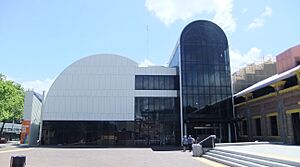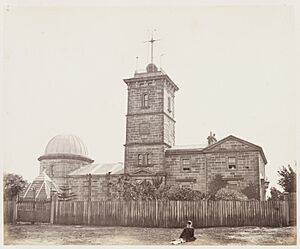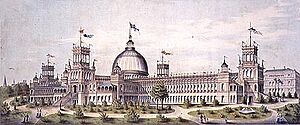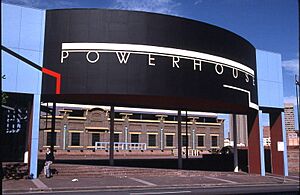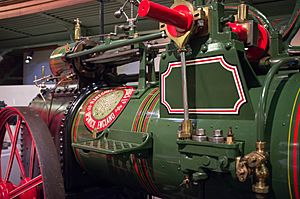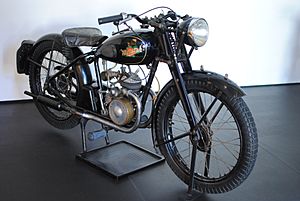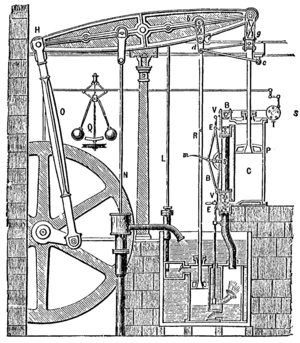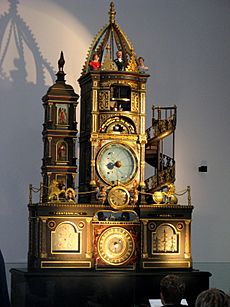Powerhouse Museum facts for kids
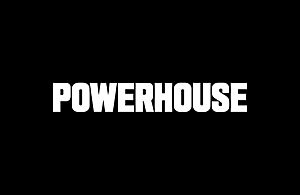 |
|
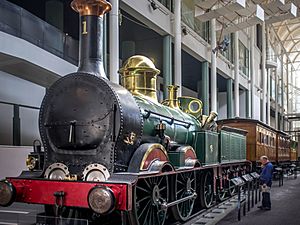
Locomotive No. 1 in Powerhouse Turbine Hall
|
|
| Lua error in Module:Location_map at line 420: attempt to index field 'wikibase' (a nil value). | |
| Former name | Technological, Industrial and Sanitary Museum of New South Wales (1879–1882) Technological Museum (until August 1893 – March 1988) |
|---|---|
| Established | 1879 as the "Technological, Industrial and Sanitary Museum of New South Wales" |
| Location | 4 locations in Greater Sydney, New South Wales, Australia: *500 Harris Street, Ultimo *Observatory Hill *Castle Hill *Parramatta |
| Type | Technology museum |
| Visitors | 757,166 (2018–19) |
| Owner | New South Wales Government |
The Powerhouse Museum, also known as MAAS (Museum of Applied Arts & Sciences), is a group of four museums in Sydney, Australia. The Government of New South Wales owns them. It is a modern museum that shows how design, new ideas, science, and technology all connect.
The Powerhouse Museum started in 1879. It is one of Australia’s oldest museums that has been open continuously. It began as part of the Sydney International Exhibition.
Today, the Powerhouse Museum has four locations in Sydney:
- Powerhouse Ultimo
- Powerhouse Parramatta
- Powerhouse Castle Hill
- Sydney Observatory
Powerhouse Ultimo has been the museum's main home since 1988. It is currently closed for big upgrades. Powerhouse Parramatta opened in 2026. It is the largest museum in New South Wales. Powerhouse Castle Hill is where most of the museum's collection is stored and researched. Sydney Observatory still offers programs about space from its historic site.
Even though it is often called a science museum, Powerhouse has one of Australia’s biggest and most varied collections. It has over 500,000 objects. These objects cover design, applied arts, science, and technology. Important areas include decorative arts, science, communication, transport, costume, furniture, media, computer technology, space technology, and steam engines.
The museum's collection has grown and moved to different places over time. It started at the Garden Palace. Then it moved to the Agricultural Hall. Later, it became the Technological Museum on Harris Street. Finally, in 1988, it moved into the former Ultimo Power Station and became Powerhouse Ultimo.
Much of the collection is kept and studied at Powerhouse Castle Hill. This place is open to the public on weekends. Since 2019, Powerhouse has been working on a huge project to digitize its collection. Millions of high-quality photos of objects are now available online. This helps more people see and learn about the collection.
Contents
- Powerhouse Parramatta: A New Museum
- Powerhouse Ultimo: The Main Site
- Powerhouse Castle Hill: Collection Storage
- Sydney Observatory: Looking at the Stars
- History of the Powerhouse Museum
- Powerhouse Museum: Future Plans
- Building Powerhouse Parramatta
- People Behind the Museum
- Exhibits and Collections
- Temporary Exhibitions
- See also
Powerhouse Parramatta: A New Museum
Powerhouse Parramatta is a new museum built along the Parramatta River. It opened in late 2026. It is the largest museum in New South Wales. The building has over 18,000 square meters of space for exhibitions and public use. This includes a 600-seat theater and a rooftop garden with telescopes. It also has a demonstration kitchen and seven large exhibition spaces without columns.
The museum was designed by Moreau Kusunoki and Genton. It is the biggest cultural building project in NSW since the Sydney Opera House.
Powerhouse Ultimo: The Main Site
Powerhouse Ultimo is in a building that used to be an electric tram power station from 1902. It has been the museum's main location since it opened in 1988. In recent years, Powerhouse Ultimo has been one of the most visited museums in Oceania.
The Powerhouse Ultimo building was designed by Lionel Glendenning. It won an award for its architecture. It has a special steam system from the old boiler house. This system powers the large, rare steam machines in the collection. The building is important because it helped change the Ultimo/Pyrmont area from an industrial zone to a cultural and educational place.
As of February 2024, the Ultimo site is closed for a big renovation project. It is expected to reopen in 2027. The project costs $300 million. It will make the exhibition spaces better and improve how visitors can move around. It will also protect the building's historic design. New features include a public square and a new main entrance facing The Goods Line.
Powerhouse Castle Hill: Collection Storage
Powerhouse Castle Hill is the main place where the Powerhouse Museum stores and researches its collection. It holds over 500,000 objects. This site is very important for keeping the museum's huge collection safe and accessible. It works with the Australian Museum and Museums of History NSW. They share storage, research, and public programs.
The facility has seven buildings for storage, conservation, and display. It holds many different objects. These range from Eddie Mabo’s shirt to Locomotive No. 1. Powerhouse Castle Hill is open to the public on weekends. Visitors can see behind the scenes of one of Australia’s largest museum collections. They can see objects not currently on display at other Powerhouse sites. The site also supports the museum's special work. This includes conservation, digitisation, and research.
From late 2004, 60 percent of the collection moved to a new 3 hectares (7.4 acres) site in Castle Hill. This facility cost A$12 million. It has seven huge sheds. One shed is as big as an aircraft hangar. Inside are items like a piece of the mast of HMS Victory. This was Nelson's ship at the Battle of Trafalgar. There is also a spare wheel from Bluebird-Proteus CN7. This was the car Donald Campbell used to break the world land speed record in the 1960s.
Powerhouse Castle Hill had a major $44 million expansion between 2018 and 2023. It was designed by Lahznimmo Architects. The new 9,000 m² addition increased storage by 30%. It also added new facilities for conservation, digitisation, research, and public programs. A special part is the “visible store.” This is a glass wall that lets you see into the Very Large Object store. This store holds planes, trains, and industrial machinery.
The project won an award in 2024 for Public Architecture. It was also considered for a 2024 Dezeen Award. This shows how well it combines public access, preservation, and good design.
Sydney Observatory: Looking at the Stars
Since 1982, Sydney Observatory has been part of the Powerhouse Museum. It became a museum and public observatory.
It is located on Observatory Hill in Millers Point. This is a historic site and an important part of the Powerhouse Museum. It was built in 1858. It has been key to Australia's science history. It was first used for keeping time and studying stars. The Observatory was important for navigation, weather forecasting, and studying the southern skies.
History of the Powerhouse Museum
The Powerhouse Museum started because of an idea from the Australian Museum in 1878. It also came from the Sydney International Exhibition of 1879. The Sydney International Exhibition was held in the Garden Palace. This building was made just for the exhibition in the Royal Botanic Gardens. After the exhibition, the Australian Museum chose the best exhibits. They wanted to show them permanently in a new museum in the Garden Palace.
The new museum was called The Technological, Industrial, and Sanitary Museum of New South Wales. Its goal was to show the newest ideas in industry, building, and design. This was to show how to improve living standards and health.
In September 1882, a fire completely destroyed the Garden Palace. The museum's first curator, Joseph Henry Maiden, was left with only a few strong objects. One was a statue of an elephant made of graphite. It survived the fire even after falling five stories.
Maiden started to rebuild the collection. For the next ten years, the new museum was in a large tin shed. It shared this space with the Sydney Hospital morgue. The smell of decaying bodies was not good for a museum about health. Finally, the museum moved to a three-story building. This was a temporary home at the Agricultural Hall. Then it moved to a new, purpose-built place on Harris Street in Ultimo. It was given a new name: the "Technological Museum."
The new location was next to the Sydney Technical College. The museum was meant to inspire the students there. Over time, its name changed to The Museum of Applied Arts and Sciences. It also opened branches in some of New South Wales' main industrial and mining towns. These included Broken Hill, Albury, Newcastle, and Maitland. The main Harris Street site quickly became too small. By 1978, many exhibits were stored in the attic and had not been shown for decades.
On August 23, 1978, Premier Neville Wran announced that the old Ultimo Power Station would be the museum's new permanent home. This was a few hundred meters north of the Harris Street site. The museum also got the nearby former Ultimo Tram Depot. The museum first opened as Powerhouse Museum – Stage One in the tram sheds. It then fully reopened as the Powerhouse Museum at the new site on March 10, 1988. The main museum building has five levels, three courtyards, and a cafeteria. Workshops, a library, storage, and offices are in the tram sheds.
The Powerhouse Ultimo made it possible to show hundreds of valuable items. Many had been stored for almost a century. In 1982, the museum also took over the Sydney Observatory. The museum moved to 500 Harris Street in March 1988. It got its new name from this new location.
After it stopped being a working observatory in 1982, Sydney Observatory became part of the Museum of Applied Arts and Sciences. From 1988, the museum used the Powerhouse Museum name more often in its advertising.
Powerhouse Museum: Future Plans
In 2015, the NSW Government planned to move the Powerhouse Museum to Parramatta. They first thought about closing the Ultimo site. After talking to the public, the government decided in 2017 that Ultimo would stay open. In 2018, they confirmed a new museum would be built in Parramatta. The final design was shown in 2019.
The new site was planned to be a 30,000 m² building. It would have 18,000 m² of public space. It was designed to hold large objects.
This project caused public discussion. Museum experts, history experts, and community groups had concerns. Issues included tearing down Willow Grove and flood risks at the Parramatta site. People also wondered if the new facilities would be good enough.
Because of public support, the decision to close Ultimo was changed in 2020. This led to a plan where both sites would operate. Ultimo would be kept and upgraded. A new museum would be built in Parramatta. This makes the Powerhouse a major cultural institution. It can reach more people across Greater Sydney.
In December 2023, Arts Minister John Graham announced that the Ultimo site would close temporarily. It closed in early February 2024 for up to three years. This is for big upgrades and redevelopment. A new public square is planned. The entrance will move to face The Goods Line walkway from Central Station.
On February 5, 2024, Powerhouse Ultimo closed temporarily. It will reopen in 2027 after major redevelopment.
Building Powerhouse Parramatta
In July 2020, the NSW Government confirmed that the Powerhouse Museum would keep its Ultimo location. They also decided to build the new museum in Parramatta. This plan aimed to give more people access to culture across Greater Sydney. It is similar to how some big museums have multiple locations.
Construction of Powerhouse Parramatta started in 2022. The design and planning stages were finished in 2020 and 2021. Lendlease was chosen as the main construction partner for this important project.
The project has reached several big steps:
- Exoskeleton Installation: The museum's unique steel frame was put in place. It has over 1,300 pieces. This allows for large exhibition spaces without columns.
- Renewable Diesel Use: Powerhouse Parramatta was one of the first big construction projects in Australia to use cranes powered by 100% renewable diesel.
- Topping Out: In May 2025, the building reached its full height of 75 meters. This marked the completion of the highest point of the structure.
The museum has over 18,000 square meters of exhibition and public space. This includes seven large, column-free galleries. It also has a 600-seat theater, rooftop gardens, and learning studios. The building's special design has reached its full height. Big construction steps, like finishing exhibition spaces, have been completed.
The museum is near the Parramatta River. To deal with flood concerns, the building's ground floor is raised. It is above a level that would only flood once in 1000 years. An open space underneath allows floodwaters to pass through without harming the main building.
A key part of the new museum is the Lang Walker Family Academy. This was made possible by a $20 million donation. This academy will offer hands-on STEM (Science, Technology, Engineering, Math) education. Over 10,000 high school students will visit each year. This includes overnight stays in a 60-bed facility. Programs started in 2022. They offer STEM education in schools across Western Sydney.
Powerhouse Parramatta is the largest museum in New South Wales. It is the first major cultural institution in Western Sydney. Nearly 10% of Australia’s population lives there. Powerhouse Parramatta is one of the most complex building projects in the world. It opened to the public in late 2026.
People Behind the Museum
In January 2019, Lisa Havilah became the CEO of Powerhouse. She was previously the director of Carriageworks. She is the fourth head of MAAS in five and a half years.
Exhibits and Collections
The museums have many permanent exhibitions. These often show different ways of transport and communication.

Key Attractions
The Powerhouse Museum has many unique exhibits. One is the oldest working rotative steam engine in the world, the Whitbread Engine. It was built in 1785. It is one of only a few made by Boulton and Watt. The museum bought it from Whitbread's London Brewery in 1888. This engine was named a Historic Mechanical Engineering Landmark in 1986.
Another important exhibit is Locomotive No. 1. This was the first steam locomotive to pull a passenger train in New South Wales. It was built in 1854. The most popular exhibit is often "The Strasburg Clock Model." A 25-year-old Sydney watchmaker named Richard Smith built it in 1887. It is a working model of the famous Strasbourg astronomical clock in Strasbourg Cathedral. Smith had never seen the real clock. He worked from a pamphlet that described its timekeeping and astronomy.
The Catalina Flying Boat Frigate Bird II is also on display. Sir Patrick Gordon Taylor flew it on the first flight from Australia to South America. He brought 29 soldiers home from New Guinea in 1945. It is the largest suspended plane in any museum. It is an example of a very successful flying boat. It was important for connecting Australia by air after World War II.
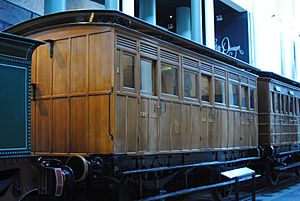
Transport History
The transport exhibition shows how transport has changed over time. It goes from horse-drawn carts to steam engines, cars, and planes. On display is Steam Locomotive No. 1243. It was used for 87 years. It is the oldest locomotive built by a contractor in Australia. It stands next to a fake railway platform. On the other side is the Governor of New South Wales's railway carriage from the 1880s.
This exhibition also has the original Central railway station destination board. It was moved to the museum in the 1980s. The Powerhouse Museum also restored locomotives 3830 and 3265. Sydney's last Hansom Cab was given to the museum by its driver. There is also a horse-drawn bus and a collection of motorbikes. Airplanes hang from the ceiling. These include the Catalina flying boat and a Queenair Scout. This was the first Flying Doctor Service plane. Among the cars is a 1913 Sheffield Simplex. It is one of only 8 in the world. A short film shows old videos of public transport.
The Powerhouse Museum also has Sydney trams: C11 (1898), O805 (1909), R1738 (1938), steam tram motor 28A, hearse car 27s, and Manly horse car 292.
The Steam Revolution
This exhibition is special because almost all the engines work. They are regularly shown running on steam power. With the Boulton and Watt engine, and the museum's locomotives, they show how steam power developed. This ranges from the 1770s to the 1930s. Engines on display include an 1830s Maudslay engine. There is also a Ransom and Jeffries agricultural engine. The Broken Hill Fire Brigade's horse-drawn pump-engine is also there. The museum has a collection of mechanical musical instruments. A fairground barrel organ is in the steam exhibition. A small fairground engine powers it.
Time and Space Exploration
The most popular exhibit is often the museum's model of the Strasbourg astronomical clock. A 25-year-old Sydney watchmaker named Richard Bartholomew Smith built it between 1887 and 1889. He had never seen the real clock. He worked from a pamphlet that described its timekeeping and astronomy. The museum bought it in 1890. The clock is made of carved and painted wood. It shows the position of planets, days of the month, solar time, lunar phases, and analog time.
The Space exhibition looks at space and discoveries about it. It has a life-size model of a space-shuttle cockpit. It also features Australian satellites. It connects to the Transport exhibit through an underground walkway.
The Powerhouse Museum has a 7 1⁄2-inch Merz Telescope. It was made in 1860–1861.
Environment and Our Planet
The EcoLogic exhibition focuses on environmental challenges. It shows how humans impact the environment. It also explores ways and technologies to stop negative effects. There is a house setup called Ecohouse. Here, people can change light settings to see the results. There are also other energy use simulators and an 'ecological footprint' game. The exhibition includes a section of a tree. It has a time line marked on its rings, going back to the 17th century.
Computers and Connections
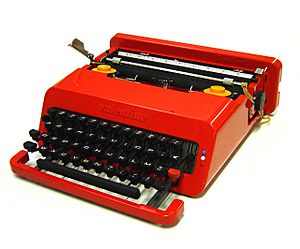
The 'Interface: people, machines, design' exhibit explores how technology has affected humans. It has a gallery of computing technology. This ranges from the typewriter to the Tamagotchi. It looks at good and not-so-good design ideas in the world of computing technology.
Experimentations in Science
"Experimentations" is a science exhibition. It has interactive displays. These show how magnetism, light, electricity, motion, and the senses work. There is a machine that explains how chocolate is made. It lets you taste four 'stages' of chocolate. There is a full-sized model of the front of a firetruck. It measures the pedal-power used to sound its horn and lights. There is also a hand-powered model railway. It uses a magnetic system to provide electric current to the track. One popular feature is a plasma ball. It shows electric current through the glowing gas inside it. It changes when touched.
Art and Industry Design
The museum has a large and important collection of Doulton ware and other ceramics. It also has industrial equipment and industrial design, like furniture.
Temporary Exhibitions
Australian Popular Culture
Various exhibitions have celebrated Australian popular culture. Some of these include On the box: great moments in Australian television 1956–2006. This was a tribute to 50 years of Australian television. The 80s are back looked back at life in Australia in the 1980s.
Arts and Fashion
Arts-focused temporary exhibitions have included the Fabergé exhibition. There was also the Treasures of Palestine exhibition and the Strictly Mardi Gras exhibition. Other shows featured Christian Dior and Audrey Hepburn. Kylie: an exhibition was a tribute to Kylie Minogue. It showed her contribution to music, stage, and screen. It featured many of her costumes. An exhibition about Diana, Princess of Wales, called Diana: a celebration, included items from her family home. These included her wedding gown and family jewelry.
Harry Potter: The Exhibition in 2011–2012 was also popular. It showed real costumes and sets from the eight Harry Potter films. These included the golden snitch, Nimbus 2000, and Firebolt broomsticks. It also had items related to the main characters.
In 2011, to celebrate their 20th anniversary, The Wiggles had an exhibition at the Powerhouse. It showed items from the group. It also included items from The Cockroaches, as two Wiggles members were in that band before. Because it was so popular, the exhibition became a permanent part of the museum.
Cinema-Themed Shows
Since 1988, the Powerhouse has hosted many large temporary exhibitions. These include ones based on popular movie series like Star Trek and The Lord of the Rings. The Star Wars: Where Science Meets Imagination exhibition showed models, props, and costumes from all six Star Wars films. It also showed new technology that is making fantasy ideas real.
See also
- German Museum of Technology – rail, maritime, aviation technology
- Musée des Arts et Métiers, Paris – scientific and cultural objects, collected since 18th century
- Museum of Science and Industry (Chicago) – transport (ships, trains, air, space)
- National Air and Space Museum, Washington, D.C.


